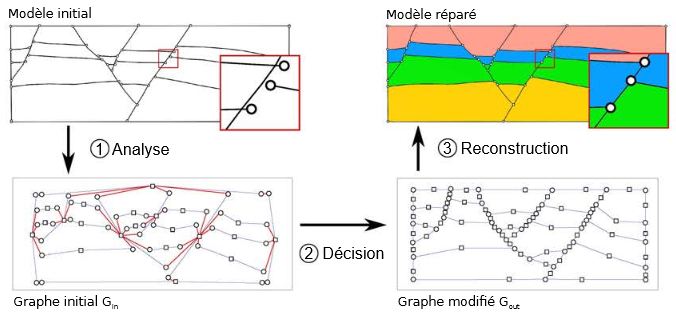Repair and simplification of geological boundary representation models : impact on mesh and numerical simulation in seismology and hydrodynamics

Abstract
Numerical geological models help to understand the spatial organization of the subsurface. They are also designed to perform numerical simulations to study or predict the rocks physical behavior. The internal structures of geological models are commonly discretized using meshes to solve the physical governing equations. The quality of the meshes can be, however, considerably degraded due to the mismatch between, on the one hand, the geometry and the connectivity of the geological objects to be discretized and, on the other hand, the constraints imposed on number, shape and size of the mesh elements. As a consequence, it may be desirable to modify a geological model in order to generate good quality meshes that allow realization of reliable physical simulations in a reasonable amount of time. In this thesis, I developed strategies for repairing and simplifying 2D geological models, with the goal of easing mesh generation and simulation of physical processes on these models. I propose tools to detect model elements that do not meet the specified validity and level of detail requirements. I present a method to repair and simplify geological cross-sections locally, thus limiting the extension of modifications. This method uses operations to edit both the geometry and the connectivity of the geological model features. Two strategies are thus explored: geometric modifications (local enlargements of the layer thickness) and topological modifications (deletions of small components and local fusions of thin layers). These editing operations produce a model on which it is possible to generate a mesh and to realize numerical simulations more efficiently. But the simplifications of geological models inevitably lead to the modification of the numerical simulation results. To compare the advantages and disadvantages of model simplifications on the physical simulations, I present three applications of the method: (1) the simulation of seismic wave propagation on a cross-section within the Lorraine coal basin, (2) the site effects evaluation related to the seismic wave amplifications in the basin of the lower Var river valley, and (3) the simulation of fluid flows in a fractured porous medium. I show that (1) it is possible to use the physical simulation parameters, like the seismic resolution, to constrain the magnitude of the simplifications and to limit their impact on the numerical simulations, (2) my method of model simplification is able to drastically reduce the computation time of numerical simulations (up to a factor of 55 in the site effects case study) while preserving an equivalent physical response, and (3) the results of numerical simulations can be changed depending on the simplification strategy employed (in particular, changing the connectivity of a fracture network can lead to a modification of fluid flow paths and overestimation or underestimation of the quantity of produced resources).
Jury Members
Supervised by Guillaume Caumon, Bruno Lévy and Jeanne Pellerin.
The president of the jury was Roland Masson.
The jury was composed of Raphaëlle Chaine, Emmanuel Chaljub, Agnès Arnould.
The rapporteurs were Raphaëlle Chaine, Emmanuel Chaljub.
Download / Links
For more information, you may also read :
- the ECMOR paper on mesh simplification for fracture networks simplification
- the CR Geoscience paper on the effect of geometric simplification on wavefield simulation.
The code corresponding to Pierre's work is SCAR.
